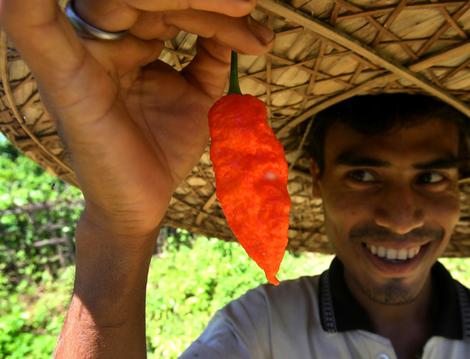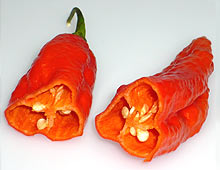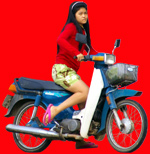  | ||
 Farmer Digonta Saikia holds a bhut jolokia | ||
The
farmer, a quiet man with an easy smile, has spent a
lifetime
eating a chilli with a strange name and vicious bite.
His mother stirred them into sauces. His wife puts them out for dinner
- raw, blood-red morsels of pain to be nibbled, carefully - with
whatever she is serving.
In the hills of north-eastern India (Assam), it is called the bhut
jolokia, or ghost chilli. Anyone who tries it, they say, could end up
an apparition.
"It is so hot you can't even imagine," says Digonta Saikia, working in his fields in the midday sun. "When you eat it, it's like dying." Outsiders, he insists, should not even try it. "If you eat one," he tells a visitor, "you will not be able to leave this place." The rest of the world should prepare itself.  For
this remote region, facing bloody insurgencies, widespread poverty and
with its major industry, tea farming, in deep decline, hope has come in
the form of the thumb-sized chilli with frightening potency. Guinness
World Records rates it the spiciest in the world.
If you think you've had a hotter chilli, you are wrong.
The smallest morsels of a bhut jolokia can flavour a sauce so intensely
it is barely edible. Eating a raw sliver causes watering eyes and a
runny nose. An entire chilli is a savage assault on the senses.
For generations, though, the bhut jolokia has been loved in India's
north-east, eaten as a spice, a cure for stomach troubles and,
seemingly paradoxically, a way to fight the crippling summer heat. For
this remote region, facing bloody insurgencies, widespread poverty and
with its major industry, tea farming, in deep decline, hope has come in
the form of the thumb-sized chilli with frightening potency. Guinness
World Records rates it the spiciest in the world.
If you think you've had a hotter chilli, you are wrong.
The smallest morsels of a bhut jolokia can flavour a sauce so intensely
it is barely edible. Eating a raw sliver causes watering eyes and a
runny nose. An entire chilli is a savage assault on the senses.
For generations, though, the bhut jolokia has been loved in India's
north-east, eaten as a spice, a cure for stomach troubles and,
seemingly paradoxically, a way to fight the crippling summer heat.
Now, with scientific proof that the chilli has more than 1 million Scoville units - the scientific measurement of a chilli's spiciness - that thrust the bhut jolokia into the record books, north-east India is taking its chilli to the world. Exporters are courting the international community of rabid chilli-lovers, a group that has traded stories for years about a mysterious, powerful Indian chilli. Farmers, too, are planting new fields of bhut jolokias, and government officials are talking about development programs. Chances are no one will get rich. In a region where good news is a rarity, however, the world record status has meant a lot of pride and a little more business. "It has got tremendous potential," says Leena Saikia, managing director of Frontal AgriTech, a food business in the north-eastern state of Assam that has been in the forefront of exports.  The
colour change of the bhut jolokia during ripening The
colour change of the bhut jolokia during ripeningThe bhut jolokia cut open. Note the three-chamber contruction. Both the mesocarp and the divider walls are rather thin. This eases drying the pepper.  |
||
Indian in record chilli attemptAn Indian mother is set for an entry into the Guinness World Records after eating 51 of the world's hottest chilli in two minutes. Anandita Dutta Tamuly, 26, gobbled up the "ghost chillis" [Bhut Jolokia] in front of visiting British chef Gordon Ramsay in the north-eastern state of Assam. Ms Tamuly told Associated Press she "felt terrible" - because she had managed 60 in an earlier local event. Mr Ramsay tried a chilli but said "it's too much" and pleaded for water. Guinness World Records accepted in 2007 that the ghost chilli was the world's spiciest at more than one million Scoville units, the measure of spiciness, twice the heat of its closest rivall. A standard green [Anaheim] chilli has about 1,500 units. The chilli record took place on Thursday in Jorhat, 300km (200 miles) north-east of state capital, Guwahati. Ms Tamuly told AP she used to eat the chilli as a child "while children of my age roamed the village to look for berries". The previous record for eating [chillies] was held by a South African with eight jalapenos in a minute. Guinness World Records has not yet formally confirmed the record. Courtesy BBC World News - 5th April 2009 |
 |  |
Check out Yorky's recipes at these sites:
































